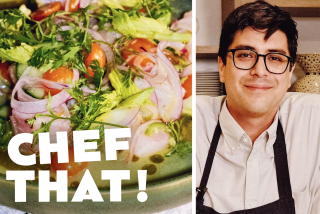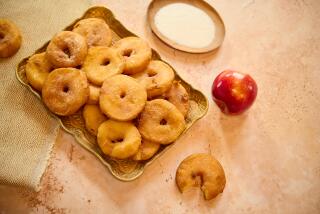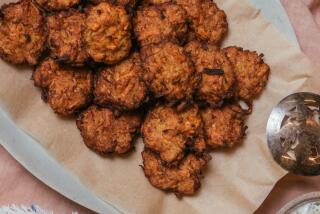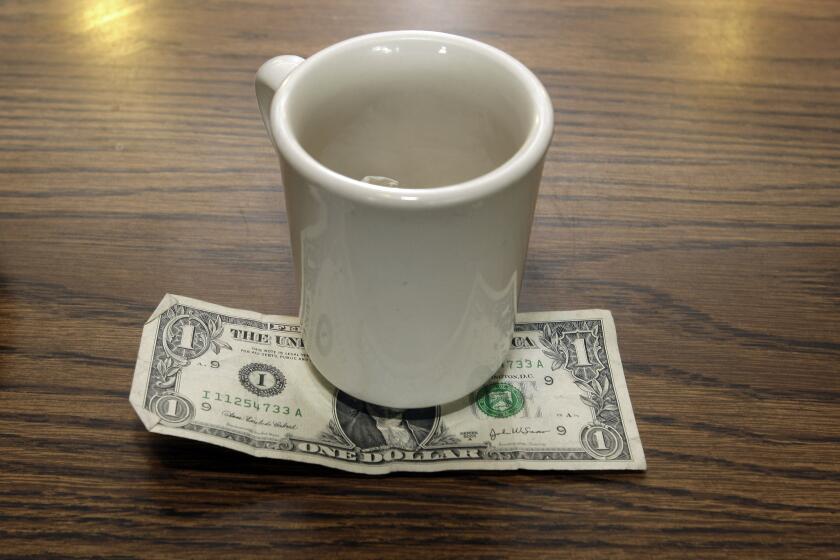The Feast of Unleavened Bread : Gefilte Fish Was a Very Big Deal
- Share via
Passover has always been my favorite holiday. Before I was old enough to understand the religious implications of the holiday, I loved the warmth it brought to my family . . . and I loved the food. Living with my grandmother for several years, I remember the enormous task in preparing for the Seder.
The day before the big dinner, we would walk to Baltimore’s Lombard Street, lined with the tiny shops of various Jewish merchants. There we gathered the ingredients necessary to feed 18 people: stewing hens for the chicken soup, roasting chickens and beef roast for the main course, fish for the gefilte fish, the freshest eggs we could find, freshly harvested fruits and vegetables, and the various matzo products--all carefully labeled “Kosher for Passover.” Every item was inspected with an eagle eye for the slightest imperfection.
*
The gefilte fish was a very big deal. It was originally considered peasant food, so the ingredients are fairly basic. Within certain guidelines, gefilte fish is traditionally made with whatever is available. My grandmother followed firm rules in selecting the fish at the market:
* You must choose four kinds of fish. Why four? The best answer she could give was, “Because that’s the way I learned it and it always works.”
* One must be carp, the predominant fish in the recipe.
* One must be whitefish. It’s a sweet, fatty fish that adds significant flavor.
* If available, pike, another sweet fish, should be used.
* Never use shad, because it makes the fish balls too hard and heavy (though shad roe added to the stock is a real treat).
* Never, ever, use a fish that is not kosher! Only fish with fins and scales can be used. Shellfish, of course, cannot be used under any circumstances.
We used to tease Grandma, offering to include shrimp and blue crab. One year, we played a trick on her: We saved a small amount of the gefilte fish mixture and cooked it in a small pot with a bit of Old Bay Seafood seasoning--the spice mixture used for steaming crabs. When Grandma lifted the lid of that pot and the distinctive aroma wafted into the air, she came close to fainting.
It was difficult for me to know exactly how Grandma directed the merchants to prepare her order because all her transactions were conducted in Yiddish. But it was clear to me that she expected quality, and no merchant would have dared offer her anything less than his best products.
Back in her tiny kitchen over the bedding store, she would carefully unwrap the packages of fish. One contained the fish fillets, another the heads, tails, skin and bones, which went into two huge pots of water to make stock. While this simmered, Grandma took down the two special pots her mother had brought from Russia--the ones that were never used for anything but gefilte fish--and began to prepare the fish for cooking.
*
She placed the filleted fish, which the merchant had ground, in a huge wooden bowl with onions and rolled up her sleeves. Then, using a chopper, she began to pound the two into the perfect texture. Having combined all the ingredients, she would carefully taste the raw mixture. She insisted it did not taste bad. How else, she wanted to know, could she be sure that the seasonings were correct?
For several years before Grandma passed away in 1984, she and I cooked all the Passover foods together. The advent of kitchen conveniences such as food processors and heavy-duty mixers made the job much less demanding, and she smiled frequently, thinking of all the energy we saved with those newfangled tools.
Choose four kinds of fish. The exact quantity of each is not important, but there should be more carp than any other fish, and you should try to get whitefish and pike, if available. One suggested porportion: 4 pounds carp fillets, 2 pounds whitefish fillets, 2 pounds pike fillets, 2 pounds halibut fillets. Ask your fishmonger to separate the heads, tails, skin and bones from the whole fish for stock and to grind the fillets (or put them through a meat grinder at home).
GRANDMA GLASER’S GEFILTE FISH
Fish heads, tails, skin and bones saved from fillets
Water
Salt
8 stalks celery, cut into 3-inch pieces
10 pounds fish fillets, ground
2 large sweet onions, chopped
1/2 cup sugar
1 teaspoon finely ground black pepper
8 large eggs
2 cups matzo meal
1 pound carrots, peeled and sliced
Paprika
Freshly ground black pepper
Cut 2 pieces of cheesecloth large enough to hold fish heads, tails, skin and bones. Place in cheesecloth and tie closed. Put cheesecloth packets in 2 large pots and cover with water. Add 1 to 2 teaspoons salt and half of celery and bring to boil. Turn heat down, cover, and simmer 2 hours.
If fish has not been ground at market, grind fish in meat grinder or in small batches in food processor.
Place ground fish in large bowl. Add onions, sugar, 2 tablespoons salt, 1 teaspoon finely ground black pepper and stir to combine. Lightly beat eggs and blend with fish mixture. Mix in matzo meal, 1/2 cup at time until mixture is almost consistency of light meatballs, adding more if necessary. (If mixture becomes too hard, add little water.)
Place fish mixture in refrigerator to allow flavors to blend while fish stock is simmering.
When stock is finished, remove cheesecloth packets, allowing packets to drain back into pot. Discard cheesecloth and fish parts. Transfer small amount of fish stock to small pot and bring to simmer. Wet hands and form ball with about 1 tablespoon of fish mixture. Place in pot, cover and cook about 10 minutes. Allow to cool 1 minute, then taste. Adjust seasonings to taste. Gefilte fish should be slightly spongy with sweet and lightly peppery taste.
When seasonings are adjusted properly, with wet hands form about 1/2 cup gefilte fish into slightly elongated shape. Lower fish ball into simmering stock. Repeat with remaining mixture, dividing between 2 pots. Avoid overcrowding. If necessary, add water to stock. Spread 1/2 carrots and 1/2 remaining celery over fish. Sprinkle with paprika and pepper. Repeat in second pot with remaining carrots, celery, paprika and pepper. Bring both pots to boil. Reduce heat and simmer, covered, 30 minutes. Remove from heat without lifting lids. Allow to stand, covered, another 30 minutes.
Serve warm or cold with warm fish stock and horseradish. Separate fish from stock before refrigerating. Gefilte fish may be reheated in stock. Makes 40 gefilte fish balls.
Each gefilte fish ball contains about:
163 calories; 480 mg sodium; 90 mg cholesterol; 5 grams fat; 13 grams carbohydrates; 19 grams protein; 0.21 grams fiber.
Most purists cringe at the thought of using a food processor to make horseradish. However, if you choose to use one, be advised not to lift the lid and take a big whiff!
BEET HORSERADISH
1 large horseradish root, peeled and cut in chunks, about 1 cup
1 (1-pound) can beets, drained
1 teaspoon salt
1/2 teaspoon white pepper
3 tablespoons sugar
1/2 to 1 cup white vinegar
In work bowl of food processor, chop horseradish, using metal blade with pulsing action. Take care not to puree. When chopped medium, add drained beets and continue to pulse until mixture is finely chopped. Remove to medium-sized mixing bowl. Combine salt, pepper and sugar and stir into horseradish-beet mixture. Add vinegar, 1 tablespoon at time, until mixture can absorb no more.
Taste to adjust seasonings. Store in tightly covered crock or glass jar in refrigerator. Makes 2 1/2 cups sauce, about 20 servings.
Each serving contains about:
16 calories; 180 mg sodium; 0 mg cholesterol; 0 grams fat; 4 grams carbohydrates; 0 grams protein; 0.20 grams fiber.
More to Read
Eat your way across L.A.
Get our weekly Tasting Notes newsletter for reviews, news and more.
You may occasionally receive promotional content from the Los Angeles Times.









